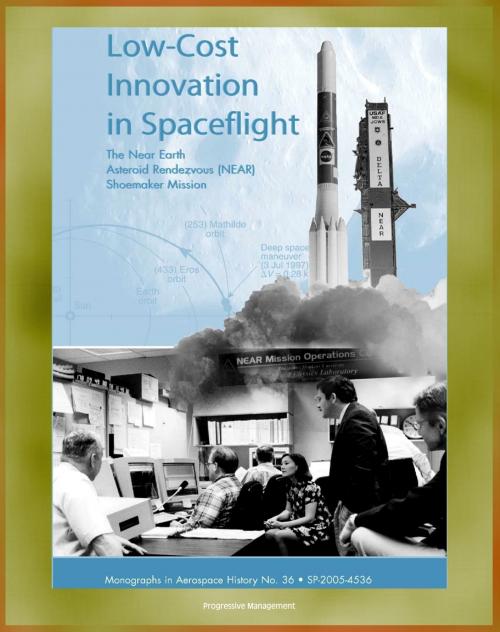NASA History: Low-Cost Innovation in Spaceflight - The Near Earth Asteroid Rendezvous (NEAR) Shoemaker Mission (NASA SP-2005-4536)
Nonfiction, Science & Nature, Science, Physics, Astronomy, Astrophysics & Space Science| Author: | Progressive Management | ISBN: | 9781466075641 |
| Publisher: | Progressive Management | Publication: | February 1, 2012 |
| Imprint: | Smashwords Edition | Language: | English |
| Author: | Progressive Management |
| ISBN: | 9781466075641 |
| Publisher: | Progressive Management |
| Publication: | February 1, 2012 |
| Imprint: | Smashwords Edition |
| Language: | English |
This NASA history document - converted for accurate flowing-text e-book format reproduction - tells the story of the NEAR asteroid mission, launched in 1996 under the "faster, better, cheaper" effort of NASA Administrator Dan Goldin, from the point of view of the management challenges involved in conducting low-cost missions while daily confronting the possibility of defeat.
The first section recounts the origins of the expedition and the struggle to get the mission funded and approved. It explains how a small group of people came to believe that an asteroid rendezvous could be conducted as a low-cost mission, a revolutionary proposition at the time. Section two concentrates on the methods employed to translate the low-cost philosophy into a robotic spacecraft that actually worked. Attention is given to the team-building techniques that allowed the people organizing the mission to simultaneously restrain cost, meet the launch schedule, and reduce risk. In section three, the management challenges involved in flying the NEAR spacecraft over the five-year flight regime are described. The difficulties were substantial, involving the guidance of a low-cost robotic spacecraft and the coordination of mission teams at three different locations. On the first rendezvous attempt with Eros, the little spacecraft missed its target, thus requiring another trip around the solar system and significant changes in organizational protocols. Finally, section four assesses the "faster, better, cheaper" initiative and the NEAR mission's contribution to it.
The scientific returns from the first sustained examination of a near-Earth asteroid were impressive. Equal to them in importance were the management lessons learned. For many decades, visionaries have predicted a future of cheap and easy spaceflight by which means humans and their machines would spread into the solar system. The NEAR mission team undertook one of the pioneering efforts in that regard, producing a spacecraft that tested not only scientific theories concerning the formation of the solar system, but also management theories on the reduction of cost.
In the years that followed, enthusiasm for the "faster, better, cheaper" initiative waned. In 1999, NASA officials lost four of the five "faster, better, cheaper" missions they attempted to fly that year. In 2003, the loss of the Space Shuttle Columbia caused experts to question the wisdom of applying cost-saving techniques to spacecraft on which humans fly. The expenses associated with planetary missions rebounded. The "faster, better, cheaper" phrase disappeared, replaced by a commitment to "One NASA," a new initiative with no major references to low-cost innovation.
The legacy of the NEAR spacecraft and the Pathfinder mission with which it once competed nonetheless remain important to the overall development of spaceflight. If humans and their machines enter space on the scale envisioned by various experts, the movement will not occur with ships that each cost billions of dollars to build. As with earlier movements into other realms, ambitious and expensive expeditions will give way to affordable technologies. The early efforts to create low-cost spacecraft contain important lessons for the people who work to make this vision come true.
This NASA history document - converted for accurate flowing-text e-book format reproduction - tells the story of the NEAR asteroid mission, launched in 1996 under the "faster, better, cheaper" effort of NASA Administrator Dan Goldin, from the point of view of the management challenges involved in conducting low-cost missions while daily confronting the possibility of defeat.
The first section recounts the origins of the expedition and the struggle to get the mission funded and approved. It explains how a small group of people came to believe that an asteroid rendezvous could be conducted as a low-cost mission, a revolutionary proposition at the time. Section two concentrates on the methods employed to translate the low-cost philosophy into a robotic spacecraft that actually worked. Attention is given to the team-building techniques that allowed the people organizing the mission to simultaneously restrain cost, meet the launch schedule, and reduce risk. In section three, the management challenges involved in flying the NEAR spacecraft over the five-year flight regime are described. The difficulties were substantial, involving the guidance of a low-cost robotic spacecraft and the coordination of mission teams at three different locations. On the first rendezvous attempt with Eros, the little spacecraft missed its target, thus requiring another trip around the solar system and significant changes in organizational protocols. Finally, section four assesses the "faster, better, cheaper" initiative and the NEAR mission's contribution to it.
The scientific returns from the first sustained examination of a near-Earth asteroid were impressive. Equal to them in importance were the management lessons learned. For many decades, visionaries have predicted a future of cheap and easy spaceflight by which means humans and their machines would spread into the solar system. The NEAR mission team undertook one of the pioneering efforts in that regard, producing a spacecraft that tested not only scientific theories concerning the formation of the solar system, but also management theories on the reduction of cost.
In the years that followed, enthusiasm for the "faster, better, cheaper" initiative waned. In 1999, NASA officials lost four of the five "faster, better, cheaper" missions they attempted to fly that year. In 2003, the loss of the Space Shuttle Columbia caused experts to question the wisdom of applying cost-saving techniques to spacecraft on which humans fly. The expenses associated with planetary missions rebounded. The "faster, better, cheaper" phrase disappeared, replaced by a commitment to "One NASA," a new initiative with no major references to low-cost innovation.
The legacy of the NEAR spacecraft and the Pathfinder mission with which it once competed nonetheless remain important to the overall development of spaceflight. If humans and their machines enter space on the scale envisioned by various experts, the movement will not occur with ships that each cost billions of dollars to build. As with earlier movements into other realms, ambitious and expensive expeditions will give way to affordable technologies. The early efforts to create low-cost spacecraft contain important lessons for the people who work to make this vision come true.















